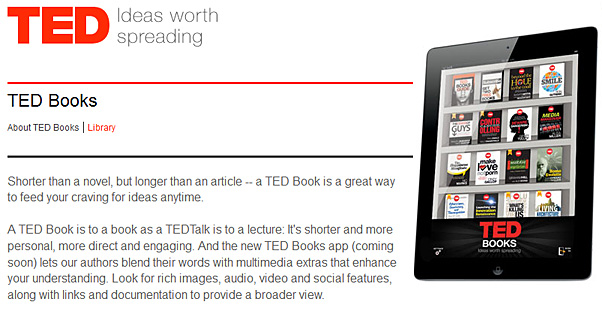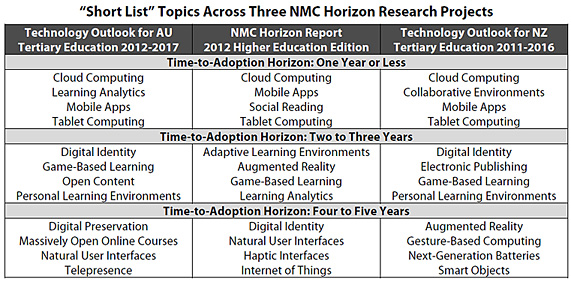[California] Governor Brown signs bills to provide free digital textbooks for students — from technapex.com by Caity Doyle
California State University selects Pearson to launch Cal State Online — from PRWeb.com
Fully online program to increase access to higher education for students.
Excerpt:
The California State University, the nation’s largest four-year university system, has selected Pearson to launch Cal State Online, a fully online program designed to increase access to higher education. Cal State Online will launch in January 2013 with a selection of undergraduate degree completion and professional master’s programs, leveraging the multitude of programs currently available across the CSU.
Also see:
Key quote/lesson from “How Barnes & Noble destroyed itself” — from fool.com by John Maxfield
An unnecessary tragedy
What makes B&N’s story tragic from a shareholder’s and book-lover’s perspective is that it wasn’t inevitable. The company would be in an entirely different position if its leadership hadn’t pooh-poohed online retail in the late 1990s, when the now-dominant Amazon was in its infancy. Consider this from its 1998 annual report: “Although it is clear the World Wide Web, with its profound possibilities, will become a major component of the future of bookselling and publishing, we believe retail bookstores will remain the foundation of our industry . . . shopping and browsing in a bookstore is an irreplaceable experience, and it is woven securely into the fabric of our American culture [emphasis added].”
From DSC:
I love going to B&N; sipping some coffee and reading a book. So don’t get me wrong, I really enjoy the physical experience of going to a bookstore. But the lesson for higher ed — as well as for the corporate world — is that technology cannot be pooh-poohed and shoved aside. Those who do so will be very sorry that they chose that route. There can be danger in pursuing the status quo.
How about your organization…is there solid representation of technology on your board/executive suite/leadership team?
My last thought here relates to my posting What happens in our hearts has very practical, relevant implications in our daily lives
In 2009, the company paid its chairman of the board, Len Riggio, nearly $600 million for B&N College, an amalgamation of campus-based bookstores that controlled the rights to the parent company’s trade name and was then owned by Riggio and his wife.
At the time, it looked like a classic covetous overreach by an executive to extract capital without selling shares. When all that’s left of B&N is a Harvard case study, however, my guess is that this blatant display of avarice and disregard for minority shareholders will be characterized more ominously as the proverbial straw that broke the camel’s back.
.
Also relevant here:
- ReadWriteWeb DeathWatch: Barnes & Noble — from readwriteweb.com by Cormac Foster
The Complete Parent’s List of Education Hashtags on Twitter — from onlinecollege.org
Excerpt:
As a parent, it’s important to be a part of the discussion about education. Informed parents can make a difference, not just in the lives of their own children, but in schools, policy, and more. You can stay in the loop and contribute your opinion by taking part in these chats and using these hashtags. Check out our list, and you’ll find more than 30 of the most relevant and useful hashtags for parents interested in education today.
10 College Business Incubators We’re Most Excited About — from bestcollegesonline.com
Excerpt:
College campuses are ripe with innovation, as students grow through education and experimentation in school. To help foster this innovation, many colleges and universities have opened business incubators, helping students and others in their community to help make their innovative dreams a reality. Whether they’re offering tricked-out labs or incredible funding opportunities, these incubators offer a great opportunity for students who are smart (and lucky!) enough to participate. Follow along as we explore 10 of the most exciting college business incubators around today, and be sure to share your own favorites in the comments.
The 10 Biggest Breakthroughs in the Science of Learning — from Online PHD Programs
Excerpt:
When it comes to human organs, none is quite so mysterious as the brain. For centuries, humans have had numerous misconceptions and misunderstandings about how the organ works, grows, and shapes our ability to learn and develop. While we still have a long way to go before we truly unravel all the mysteries the brain has to offer, scientists have been making some major breakthroughs that have gone a long way in explaining both how the brain functions and how we use it to organize, recall, and acquire new information. Here, we list just a few of the biggest and most impactful of these breakthroughs that have contributed to our understanding of the science of learning.
10 BYOD Classroom Experiments (and What We’ve Learned From Them So Far)” — from
Excerpt:
With budgets tight, many schools are hoping to bring technology into the classroom without having to shell out for a device for each student. A solution for many has been to make classes BYOD (short for “bring your own device”), which allows students to bring laptops, tablets, and smartphones from home and to use them in the classroom and share them with other students. It’s a promising idea, especially for schools that don’t have big tech budgets, but it has met with some criticism from those who don’t think that it’s a viable long-term or truly budget-conscious decision. Whether that’s the case is yet to be seen, but these stories of schools that have tried out BYOD programs seem to be largely positive, allowing educators and students to embrace technology in learning regardless of the limited resources they may have at hand.
The 25 Best Resources For Finding Nonprofit Jobs — from bachelorsdegreeonline.com
Excerpt:
Finding a job that helps you make ends meet is great, but finding one that helps you make a real, lasting difference in the world can be even better, especially for those who have always dreamed of a career in the nonprofit or social services sectors. Luckily, there are a number of incredibly useful sites on the web that can help you network, share your resume, and find nonprofit job openings in your area. We’ve shared 25 of them here so you can get your nonprofit job search started on the right foot and hopefully find a job that lets you make a positive impact on the world and your community.
8 Career Mistakes New Grads Make (and How to Avoid Them) — from onlinedegreeprograms.com
Excerpt:
You’ve crossed the stage, thrown your hat in the air, and entered the real world. You’re probably eager to get your career started and are already thinking ahead 10 years when you’ll be running a company, saving the world, and making wads of cash. But slow down there, new grad. Your career starts with baby steps and avoiding some of the common mistakes young workers make. If you follow these tips and stay away from some pitfalls, you’ll be in that corner office in no time.
15 Libraries Taking Summer Reading to the Next Level — from the Online Education Database
Excerpt:
While not an exhaustive list (there are a lot of amazing libraries out there), here we highlight some of the libraries we think are going above and beyond in their summer reading initiatives, offering programs and activities that help readers spend their summers reading, learning, sharing, and growing.
8 Predictions for the Future of Academic Publishing — from the Online Education Database
Excerpt:
University presses and academic journals may perpetuate the world’s most groundbreaking research, but they tend towards the heavily conservative when it comes to changing anything and everything about their organization. But the inevitable influx of digital and new media ventures has already started trickling into the tightknit institutions, and many scholars are already calling for a dismantling of the old — and often unwieldy and inaccessible! Some of the latest experiments will stick, while others will go all Crystal Pepsi on humanity. Until time decides to tell, the following represent a few things academics are saying about where their research might be headed.
Top 25 Education Blogs for Proactive Parents — from onlinecollege.org
Excerpt:
As a parent, it’s your job to look ahead and plan for the future, whether that means packing lunch or creating a roadmap for college. Perhaps one of the most important things parents can look ahead to is education. School reform, college, and getting involved as a parent are all important topics for parents to stay on top of, and these blogs all offer great ways to do so. We’ve discovered 25 of the best education blogs for proactive parents, and we encourage you to check them out.
Investing in your own disruption — from edcetera.rafter.com by Kirsten Winkler
Excerpt:
What do you do when you realize that the business you have been building over the past decades, if not centuries, is toast? Well, you can entrench yourself and fight the last battle, trying to squeeze as much as possible out of what is left, or simply call it a wrap and move on.
Publisher Macmillan seems to have chosen the latter. PandoDaily published an interesting post about Macmillan New Ventures, a $100 million (or more) fund led by former Questia Media CEO Troy Williams. The task: invest in education technology startups that will eventually disrupt the publishing industry.
Create an interactive eBook for the iPad using iBook Author: The Complete Guide — from easytechsite.com by Shawn Ozbun
Also see:
By Nellie McKesson, Adam Witwer
Publisher: O’Reilly Media / Tools of Change
Released: February 2012
Pages: 108
Excerpt:
T.H.E. Journal is entering a new era in its 40-year history as a magazine serving the educational technology market. Beginning with its August issue, T.H.E. Journal will become an entirely paper-free, digital publication. The June/July issue will be its last as a traditional print magazine.
…
This all-new T.H.E. Journal far exceeds the standard pdf versions people have come to associate with digital magazines. In fact, our traditional coverage will be enhanced by a variety of multimedia elements that will augment your understanding and knowledge of the field we cover. Along with text-based articles, there will be video interviews and demonstrations of the technologies we discuss, infographics, podcasts, and a greater selection of multimedia slideshows.
Adobe announces next generation of Digital Publishing Suite
Over 25 Million Digital Issues Delivered to Date, 120,000 Downloads Every Day; Meredith Corporation Selects DPS
Excerpt:
NEW YORK — May 15, 2012 — At Adobe’s annual Digital Publishing Summit, Adobe Systems Incorporated (Nasdaq:ADBE) today announced a series of groundbreaking new features for Adobe® Digital Publishing Suite (DPS) that will allow media companies and corporate publishers to deliver unparalleled reach and monetize their unique content in new ways. Among the new features are Content Viewer for iPhone, social sharing, expanded font licensing and enhanced integration with Adobe Creative Suite® 6, a milestone release, creating an unbeatable combination for media and corporate organizations. Adobe is live blogging from the Summit at blogs.adobe.com/dpsnyc2012.
Addendum on 5/17/12:
- Adobe’s updated Digital Publishing Suite means more magazines for the iPhone — from techcrunch.com by Chris Velazco
McGraw-Hill report demonstrates power of adaptive learning technology to personalize education and support needs of 21st century students — prnewsire.com
Report illustrates how personalized learning is the key to engage, retain and graduate students and prepare them for the global workforce
NEW YORK, April 12, 2012 /PRNewswire/ — A new report released today by the McGraw-Hill Education characterizes adaptive learning technology as the lynchpin in personalizing education in today’s K-12 and higher education classrooms. According to the report, adaptive learning technology, also known as a computer-assisted smart tutor, helps teachers tailor instruction for every student in the class, effectively creating a “class of one” and significantly improving learning outcomes.
…
The authors highlight three of McGraw-Hill’s adaptive programs:
- LearnSmart is the leading interactive study tool for higher education that adaptively assesses students’ skill and knowledge levels to track which topics students have mastered and which require further instruction and practice. It then adjusts the learning content based on students’ strengths and weaknesses…
- Power of U is a revolutionary, digitally rich personalized middle school math pilot program that uses real-time assessment data to group students in ways that allow them to learn at their own pace, in their own style, using the medium that works best for them…
- ALEKS®, one of the pioneer products to use adaptive learning technology, is a web-based assessment and learning system created by the ALEKS Corporation and exclusively distributed by McGraw-Hill Higher Education to colleges and universities.
.
From DSC:
These are the types of technologies that will make their way into courses that you can take from your Smart/Connected TV (i.e. “learning from your living room” and “The Forthcoming Walmart of Education” trends continue to develop and are moving one step closer to reality).













